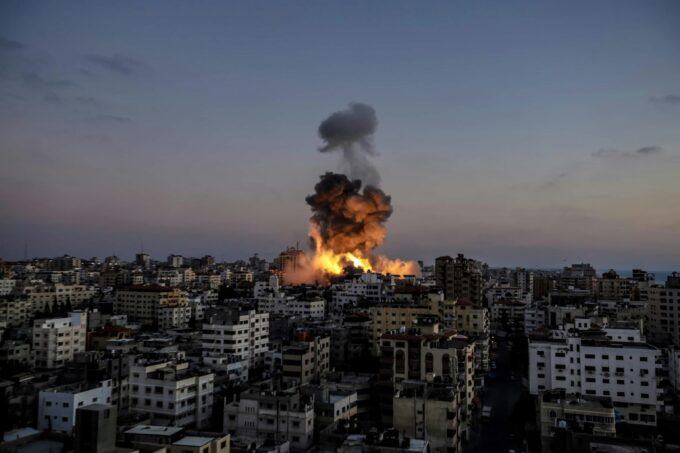
Image by Mohammed Ibrahim.
Damage Control
President Trump’s childish and out-of-touch message following US strikes on Iran is now, properly, a matter of contention. He said:
“Iran has officially responded to our Obliteration of their Nuclear Facilities with a very weak response, which we expected, and have very effectively countered. . . . Most importantly, they’ve gotten it all out of their ‘system,’ and there will, hopefully, be no further HATE. Perhaps Iran can now proceed to Peace and Harmony in the Region . . .”
Leaving aside the absurd notion that bombing a country can produce peace and harmony, the finding of “Obliteration” is clearly wrong.
Following Trump’s comment, other less grand assessments of the US strikes have been offered, ranging from “enormous damage” and “severe damage” to the Ayatollah Ali Khomeini’s insistence that “nothing at all” was seriously damaged. Accompanying these assessments of what bombing accomplished are wide-ranging predictions of how badly Iran’s nuclear program has been set back: a few months, several months, several years. All these assessments and predictions obscure a simple fact: Iran still has the human and technical resources to produce a nuclear weapon at some point in the future, and now with greater incentive than ever to do so.
Several expert accounts note that the air strikes sealed off the entrances to two of the three Iranian nuclear facilities but did not collapse their underground buildings. The Defense Intelligence Agency’s report, which cites a three-month setback for Iran, said that much of Iran’s stockpile of enriched uranium was moved before the strikes, which destroyed little of the nuclear material.
Iran may have moved some of that to secret locations. Other officials noted that the report found that the three nuclear sites — Fordo, Natanz and Isfahan — had suffered moderate to severe damage, with the facility at Natanz damaged the most. Herbert Lin, a Stanford University research fellow, analyzed the US attack for the Bulletin of the Atomic Scientists and underscored two key problems with the “obliteration” thesis:
“First, the United States bombed known nuclear facilities. If the Iranians had a secret, undeclared facility—e.g., for uranium enrichment—this attack did not touch it. Second, this attack appears to have been an attack on the Iranian facilities for the enrichment of uranium, and not on Iran’s existing stockpiles of enriched uranium. If enriched uranium were located at Fordow or Isfahan, the trucks seen at these facilities before strikes on them could easily have removed that material—moving materials is a generally easier task than moving delicate machinery.”
Trump has been angered by news reports that have raised questions about the extent of the damage to Iran’s nuclear facilities. The White House spokeswoman, Karoline Leavitt, said:
“The leaking of this alleged assessment is a clear attempt to demean President Trump, and discredit the brave fighter pilots who conducted a perfectly executed mission to obliterate Iran’s nuclear program, Everyone knows what happens when you drop 14 30,000-pound bombs perfectly on their targets: total obliteration.”
Well, not everyone knows; but to fail to acknowledge that the nuclear sites were obliterated is to fail the administration’s latest test of fealty. Tulsi Gabbard, the director of national intelligence, failed the test, and has tried to recover by citing “new intelligence” to support Trump’s position. But several reporters have endured Trump’s (and Pete Hegseth’s) wrath for questioning their claims.
Unintended Consequences (or, You Reap What You Sow)
Perhaps most importantly, the bombing of Iran has demonstrated anew the Trump administration’s lawlessness. It acted like the George W. Bush administration when it launched the Gulf War and twisted intelligence to falsely claim an Iraqi WMD program.
But at least Bush (after deploying troops) obtained authorization from Congress. Trump began by carrying out a preemptive strike on Iran, without evidence that Iran had weaponized, or was close to weaponizing, its enriched uranium. Then the administration failed to consult with Congress and defied the War Powers Act. (The Senate has just voted against a Democratic bill that would have required congressional approval of further US military action against Iran.)
Now, questioning of Trump’s assessment of the bombing has led the administration to limit intelligence sharing with Congressional committees. To make the point, Tulsi Gabbard was not among the four administration officials who briefed Congress members on the bombing of Iran. John Ratcliffe, the CIA director, who has toed the line on the level of destruction of Iran’s nuclear sites, replaced Gabbard.
The US, Israel, and other countries should be worried now about Iran’s reaction to being struck so devastatingly. As Herbert Lin concludes:
“The technical challenges of destroying deeply buried sites, the possibility of relocated materials, the impossibility of destroying Iranian knowledge and expertise about uranium enrichment and weapons design and production, and the resilience of the Iranian regime all suggest that this may be only a temporary setback, and any long-term solution will not lie in a military-only approach.”
That last point is especially important: More bombing cannot end Israel’s or the US’s problem with Iran; only negotiations can. Otherwise, consider Iran’s possible moves:
It will withdraw from the Nuclear Nonproliferation Treaty, just as North Korea withdrew in 2003.
It will kick out the International Atomic Energy Agency’s nuclear inspectors.
It will conduct a nuclear test several months from now to demonstrate that its nuclear sites were not obliterated.
It will step up attacks on Israel by proxies in Yemen, Lebanon, and Iraq.
When all is said and done, will the Trump-Netanyahu bombing strategy still be hailed by their supporters as a great success?
The post The Failure to “Obliterate” Iran’s Nuclear Sites appeared first on CounterPunch.org.
This post was originally published on CounterPunch.org.